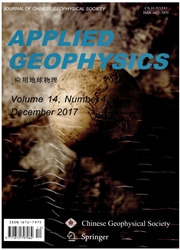

 中文摘要:
中文摘要:
Biot 理论研究在实际岩石中被扩大了到多尺度的异质。集中于实验室频率带宽研究,我们讨论在双孔和 BISQ 波浪方程之间的关系,经分解为 double-porosity 的回来导出退化方法到 BISQ,并且给三退化必须满足的必要条件。由介绍动态渗透和扭曲理论,一系列动态双孔波浪方程被导出。狭窄的乐队近似被做为动态双孔波浪领域简化数字模拟。最后,伪 spectral 方法在实验室频率乐队(50 kHz ) 以内被用于波浪模拟。数字结果为动态 double-porosity 对喷射流动的描述和伪静电干扰近似方法的有效性证明了可行性。
 英文摘要:
英文摘要:
Biot theory research has been extended to the multi-scale heterogeneity in actual rocks. Focused on laboratory frequency bandwidth studies, we discuss the relationships between double-porosity and BISQ wave equations, analytically derive the degeneration method for double-porosity's return to BISQ, and give three necessary conditions which the degeneration must satisfy. By introducing dynamic permeability and tortuosity theory, a full set of dynamic double-porosity wave equations are derived. A narrow band approximation is made to simplify the numerical simulation for dynamic double-porosity wavefields. Finally, the pseudo-spectral method is used for wave simulation within the laboratory frequency band (50 kHz). Numerical results have proved the feasibility for dynamic double-porosity's description of squirt flow and the validity of the quasi-static approximation method.
 同期刊论文项目
同期刊论文项目
 同项目期刊论文
同项目期刊论文
 期刊信息
期刊信息
